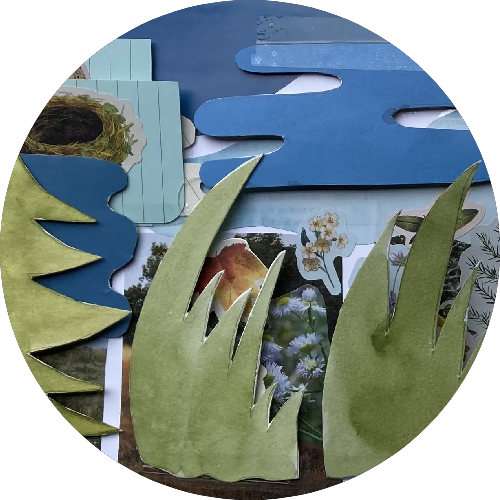Tactile Poem
Artist
This provocation explores landscapes — personal, imaginary, natural, and urban — in life, in poetry, and in visual art. My handmade books of tactile poetry use materials foraged from the land, such as a vibrant green ink I make from invasive buckthorn tree berries. I like to investigate relationships between humans and non-human beings and explore the possibility for land to have consciousness and carry stories. By combining visual art and poetry to create landscapes that tell a story, this project melds visual art into poetry so that images play with words, words inspire images, and the physical act of ‘unfolding’ the piece becomes part of its poetry.
Nyssa Komorowski is a graduate of OCAD University and University of Toronto, studying cross-disciplinary art, art history, book history, and print culture. She makes illustrations that draw from the oral tradition of her Indigenous culture (Oneida Nation of the Thames) and personal experiences. Maps, the animacy of land, and the performance of stories inspire her work. Her writing and illustration work has been published by CBC, Shameless Magazine, smART Magazine, Canthius, Maisonneuve, University College Alumni Magazine, and Broadview.
Nyssa Komorowski
Make your personal landscape.
Invitation
Visit a landscape for inspiration. Forage a few materials that could be used in a collage, like leaves, small twigs, or flowers. Some plants can be used to make your own pigments and inks.
Think about words that describe the land. What kind of stories happen here? Can you personify it or give it human emotion? Write down a list of words and phrases on a piece of paper.
At home, cut shapes from paper to represent plants, animals, weather phenomena, land formations, or structures in your landscape. You can use whatever is on hand, including materials you foraged, drawings, mixed media, stickers, or magazine clippings.
Glue or tape these down on paper to make your personal landscape. Try making flaps that can be flipped and pockets to tuck things into. Think about making layers. Let the words and phrases you wrote guide the imagery you create.
Cut out your words and phrases and arrange them on the collage. Think about how you can use the flaps and pockets you created. Rearrange and experiment until you’re ready to paste or tape it together into a tactile poem.
BONUS: Foraging Ink
Are there buckthorn trees in the landscape you visited? Try making this vibrant green ink from the ripe berries.
Gather ripe buckthorn berries in late fall or early winter. You will need at least a handful to make a small quantity of ink that would fit into a mason jar.
Squish the berries in a pot and add water. One handful of berries + 1-2 cups of water should work, but you can experiment with different quantities.
Boil and squish the berries until the berries are soggy and have lost some of their colour.
Test the colour. If it isn’t dark enough let it boil longer to reduce and concentrate the solution.
Strain with a fine mesh sieve.
Add a small scoop of alum to activate and enhance the green colour — ½ teaspoon for a cup or two of water should work.
Use the liquid as a dye or ink. Store in the fridge with a tightly fitting lid. Will last a few months to a year.
